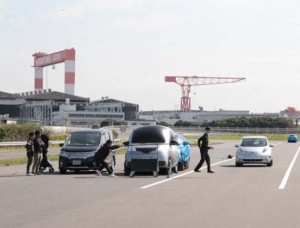
Nissan's Autonomous Emergency Steering System automatically tries to avoid obstacles like pedestrians who dart into the road.
It’s the sort of situation that repeats itself countless times in every city every day: the motorist is maneuvering his way along a crowded urban road when a pedestrian darts out into traffic. All too often the result is a serious, perhaps deadly collision. But this time, rather than panic, the driver simply loosens his grip on the wheel and the Nissan Leaf suddenly darts into an adjacent lane, steering itself clear of the pedestrian.
For the moment, the scene was a very real simulation staged at the Nissan test track in the Tokyo suburb of Oppama, but the Autonomous Emergency Steering system may soon show up in a production model, company planners suggested during a presentation of the Japanese maker’s latest technology.
Among the other systems Nissan hopes to bring to market in the next year or so is a new steer-by-wire system that uses technology borrowed from the latest military fighter aircraft. Likely to show up first on one of the maker’s Infiniti luxury models, a steer-by-wire system could translate into a more precise drive that doesn’t lead to fatigue as motorists jounce and judder over potholes, crowns and ruts, according to Nissan.
While government regulators are likely to require an emergency mechanical backup, the new steer-by-wire system disconnects the wheel in the driver’s hand from the ones making contact with the road. Instead, special sensors and electronic control modules measure the precise driver input and feed that to a pair of motors that move the vehicle’s otherwise conventional steering rack.
But this is no video game. Road inputs are, in turn, sensed and fed back to the driver through a motor attached to the steering wheel. During several turns around the Oppama track the steer-by-wire system felt surprisingly crisp and natural.
One big difference was the way the technology compensated by the jarring bumps that a motorist normally experiences while traveling down a bumpy road. There was still plenty of feedback but it appeared less fatiguing and required less driver effort to compensate for, especially when maneuvering a steeply crowned street.
With a flick of a switch, a Nissan engineer shifted the system from normal to more sporty mode, giving the Infiniti test sedan a much more aggressive feel. There’s still some final tweaking and tuning, officials with the program concede, but they’re confident enough that Nissan is all but confirming plans to launch the steer-by-wire system sometime in 2013.
By shifting to a fully electric steering system, Nissan eventually hopes to come up with a variety of advanced safety technologies. The Autonomous Safety System, however, will be able to work on a car equipped with conventional, mechanical steering, as well.
A prototype Nissan Leaf battery-electric vehicle is equipped with vision systems at all four corners, as well as short-range sonar and a laser scanning system. That allows it to constantly monitor what is going on around the vehicle. In the demonstration of the Autonomous Safety System, when a dummy is suddenly rolled out in front of the Leaf the vehicle immediately looks for an escape route. If possible, it will try to simply steer away from the obstacle. If not, the system will aggressively apply the brakes in order to minimize any impact.
While the Autonomous Safety System isn’t quite ready for production, yet, Nissan officials hope to have it refined enough for real-world use within the next several years.
It would become part of the maker’s so-called Safety Shield technology which Nissan hopes can help cut the number of deaths and serious injuries that occur in its vehicles by three-quarters by early in the next decade.
